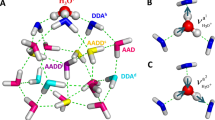Abstract:
Mass-resolved resonant two photon ionisation (R2PI) and infrared ion dip spectra have been recorded for 4-phenylimidazole (4PI) and its singly and multiply hydrated clusters 4PI(H2O)n = 0 - 4, under supersonic expansion conditions. In the case of 4PI(H2O)0,1, it has also been possible to record infrared spectra in both the ground (S0) and excited (S1) states. Combining the experimental data with the results of ab initio calculations has led to the structural assignment of each cluster. In each case, the water molecules bind primarily to the NH site of the imidazole ring. Clusters with n≥ 2 incorporate linear water chains, in which the proton donating terminus bridges either to the π-electron system (n = 2) or to the >N: atom site (n = 3, 4) on the imidazole ring. Despite the creation of a “water wire”, connecting the donor and acceptor sites of imidazole, there is no evidence of proton transfer in either the ground or excited state.
Similar content being viewed by others
Author information
Authors and Affiliations
Additional information
Received 20 December 2001 Published online 13 September 2002
Rights and permissions
About this article
Cite this article
Talbot, F., Simons, J. Infrared ion dip and ultraviolet spectroscopy of 4-phenyl imidazole, its tautomer, 5-phenyl imidazole, and its multiply hydrated clusters. Eur. Phys. J. D 20, 389–398 (2002). https://doi.org/10.1140/epjd/e2002-00146-7
Issue Date:
DOI: https://doi.org/10.1140/epjd/e2002-00146-7




